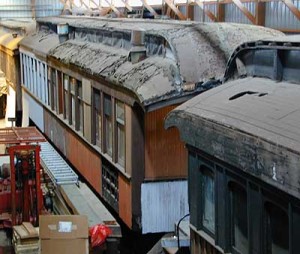Milwaukee, Lake Shore & Western first class coach #63 Fund Drive and Restoration
Text by Don Ginter and Ray Buhrmaster
All Content ©2000, Mid-Continent Railway Historical Society, Inc.
Reproduction, copying, or redistribution without permission is prohibited.
If you have ever visited or seen views from the California State Railroad Museum, Nevada State Railroad Museum, Railroad Museum of Pennsylvania, or the B&O Railroad Museum, you probably marveled at their restored coaches and locomotives. The only difference between what they have done and what Mid-Continent can do is governed by time and money. We now have an opportunity to duplicate their restoration work.
In the past, our coach restorations have normally taken up to ten years to complete. When volunteers can only work one weekend a month, restorations take years to complete. Also, our restoration plan for a particular piece of equipment is often guided by the amount of money available from the museum’s budget. These two items (time and money) may not always allow a restoration to the most historic era. This could now change with our next coach restoration.
The Jeffris Family Foundation has awarded Mid-Continent a challenge grant for the restoration of its 1888-built MLS&W #63 coach (seen in the photo above about 1910 when it was owned by and lettered for the Chicago & North Western Railway). The total budget for the restoration/reconstruction of the coach is $350,000; the Jeffris Family Foundation challenge grant is for $175,000. We will provide the matching $175,000, which was successfully raised by the end of August 2000.
This budget will allow restoration of the MLS&W #63 to its 1888-1893 configuration as an MLS&W coach with Miller hook couplers, Spear heaters, and interior artistry by E. Colonna. Certainly, this is a task that the normal museum budget could not afford. Second, with this budget, the work will be done by hired professional people experienced in the railroad restoration field and other fields of restoration work. The restoration will be completed in two years. It could be done sooner, except our shop is not equipped with heat for winter work.
Major donors and gifts from our membership have raised the $175,000 in matching funds needed. Further donations will be accepted to help with contigencies. Read on to learn a little bit of the history of our “Lake Shore” #63, and continue visiting Mid-Continent’s website for future updates on the restoration, slated to begin in November 2000.
Historical Perspective 1888-1990
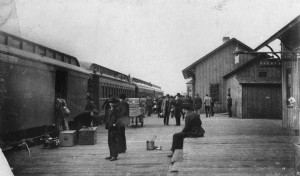
Passenger and freight business was brisk this day, as a Lake Shore passenger train stops at Antigo, Wisconsin. Langlade County Historical Society.
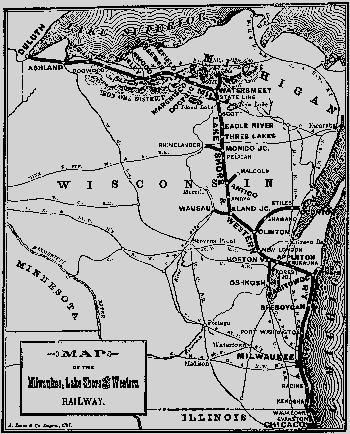
Milwaukee, Lake Shore & Western Railway passenger coach #63 was one of an order of seven cars built for the road in 1888 by the Barney & Smith Manufacturing Company of Dayton, Ohio. The cars, numbered 58 through 64, were received and placed in service during the month of August. Also in 1888, the Lake Shore road received five new locomotives and some 550 freight cars. Additionally, bids were being sought for another 500 new box cars. The year 1888, indeed, was one of tremendous expansion for the line.
The Milwaukee, Lake Shore & Western Railway had its beginnings in 1872 with the reorganization of several predecessor roads including the Appleton and New London Railway and the Milwaukee, Manitowoc & Green Bay Railroad. The MLS&W could trace its origin to the granting of a right-of-way to the Manitowoc and Mississippi Railroad in December of 1853.
By 1888, the Lake Shore was operating daily mainline passenger trains on the Milwaukee to Ashland route as well as frequent branch service to Rhinelander, Wausau, Oconto, Two Rivers and Oshkosh. Schedules indicate that almost eleven hours were required for the 367-mile Milwaukee-Ashland run. Coach #63 would have provided first- class accommodations on any of the Lake Shore mainline assignments. There were 48 passenger cars in use in 1888 made up of baggage-smokers, smoking or second-class coaches, first-class coaches, and four parlor cars. The three sleeping cars used by the MLS&W were furnished by the New York Sleeping Car Company.
Coach #63’s builder, the Barney & Smith Manufacturing Company, was a pioneer supplier of rolling stock to midwestern railroads. The company had its start in 1849 in Dayton, Ohio, as a partnership between educator Eliam E. Barney and former Baptist minister Ebenezer Thresher. This unlikely team, with only $10,000 in capital, had slow going through their first decade. In 1867, with several additional partners, the joint stock company of Barney & Smith Manufacturing Company was formed. Capital was at $500,000 and car production was twenty freight cars and two passenger cars per week. The works employed 350 men. The car works weathered the financial gales of the 1870s and expanded considerably in the 1880s. By 1880 Barney & Smith employed over 2000 workers and produced almost six percent of the total car production in a country already overcrowded with car builders. The Barney & Smith Car Company was formed in 1892 when the Barney family sold out to Cincinnati interests and the firm became publicly traded. The formation of car giants Pullman and American Car & Foundry Company plus Barney & Smith’s inability to successfully compete in the steel car market resulted in the closing of the famous works in 1922.
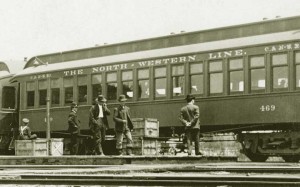
Noted postcard photographer J.M. Colby was certainly unaware of the historical significance of this scene he’d just recorded. C&NW coach #469, aka MLS&W #63 was part of the passenger consist when he photographed this north bound train at Eland Jct., c.1910. Photograph by J.M. Colby, Marathon County Historical Society, Wausau, Wisconsin. This is the only known actual photo of Mid-Continent’s MLS&W #63 while it was in passenger service.
In 1881, Barney & Smith retained noted architect Bruce Price as a car interior design consultant. Interior design had become a major consideration in the 1880s and it was necessary that cars bear a statement in regard to woodwork, fixtures, and colors. In 1885 Edward Colonna, a Price assistant, was hired as Designer-in-Chief. Colonna’s name became familiar to many as a leading Parisian exponent of Art Nouveau in later years. Under Colonna’s direction, the car works organized a carving and marquetry department, employing perhaps a hundred skilled woodcarvers. Barney & Smith soon became well known for their Colonna-inspired interiors. Colonna’s tenure at Dayton was brief. He left in October 1888, for Montreal where the Canadian Pacific Railway would become his major client. Lake Shore coach #63 is probably the most intact example of Colonna-era car design in existence today.
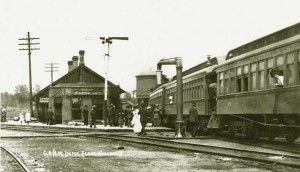
C&NW coach #478 (ex-MLS&W #73, similar to ex-MLS&W #63) is shown with another former MLS&W coach in the consist of a south bound passenger train at Eland, Wisconsin, c.1910. Photograph by J.M. Colby, collection of Ray Buhrmaster
MLS&W first-class coach #63, as received, was typical of open-platform cars being built in the day preceding the use of steel. The car measured 49’2″ inside, was of all-wood framing, and contained reversible seats for 51 passengers. The car rode on wood-framed 4-wheel trucks and made use of the patented Miller hook coupling and platforms. The hook coupling was a definite improvement over link and pin couplings of the day by providing resistance to platform collapse during derailments or wrecks. The Miller coupler, by means of spring buffers, eliminated “slack action” between cars. Coach #63 was ventilated by use of a then-conventional clerestory equipped with 17 movable windows on each side. Heating was accomplished by means of two car stoves, one located in each opposite end corner of the car. Coach #63 may have been delivered with steam heating equipment as the Kaukauna Sun of January 25, 1889, details the departure of the Lake Shore road’s first steam-heated passenger train on the day previous. Dual heating systems were not uncommon as stoves provided a margin of safety should the steam heat lines freeze in extreme weather.
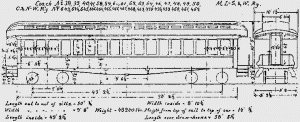
C&NW coach #478 (ex-MLS&W #73, similar to ex-MLS&W #63) is shown with another former MLS&W coach in the consist of a south bound passenger train at Eland, Wisconsin, c.1910. Photograph by J.M. Colby, collection of Ray Buhrmaster
Seating consisted of 25 wood-framed reversible seats and one fixed seat. Seat covering was probably plush of an unknown color. Toilet facilities were provided by two saloons. The ladies saloon was 6’4″ long by three feet wide and contained a dry hopper and a sink. The men’s saloon was half as long and contained only a hopper. Washing was done at a sink secured to the outside wall of the saloon. Car lighting was furnished by five double-burner oil ceiling lamps. Bracket type oil lamps illuminated each saloon.
Interior finish of coach #63 was a highly polished cherry wood with much of E. Colonna’s ornamentation visible on window columns, bulkheads, and end door headings. The ceiling and headlining were covered with curved oak veneer stenciled with Colonna- inspired patterns. All of the coach’s hardware, lamps, hoppers, and basket racks were furnished by the Dayton Manufacturing Company. Dayton was established in 1882 by Eliam Barney and others to insure a steady supply of car hardware at reasonable rates. Decoration on Dayton’s car furnishings also reflect the designs of Edward Colonna. Evidence of this is especially noted in Dayton coach lamps of the period but can be found in such minor items as door hinges.
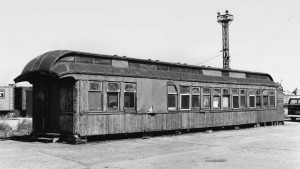
A diamond in the rough has been found! MLS&W coach #63, disguised since 1930 as C&NW’s Wood St. Potato Mart office in Chicago, is examined by its new owners, Mid Continent Railway Museum, in October 1970 prior to its move to the museum. Photograph by Ray Buhrmaster.
By 1893, the Milwaukee Lake Shore & Western had become a major Wisconsin carrier and thus attractive to the expanding Chicago & North Western Railway. Since the Lake Shore depended upon the C&NW for a Chicago connection as well as numerous interchange locations, it was apparent that the interests of both lines could be well served by an alliance. This was accomplished by September 1893. Some 733 miles of Lake Shore road as well as 112 locomotives, 77 passenger train cars, and over 5000 freight cars became the property of the C&NW. The Kaukauna Sun of October 27, 1893 reported that a dozen painters in the shops were engaged in the painting out of the Lake Shore name on all cars and the re-stenciling with the North Western legend. It was at this time that Lake Shore coach #63 became Chicago & North Western coach #469.
The history of coach #469 during the early years of its North Western ownership is virtually undocumented. Photographs extant of other former MLS&W 1888 coaches do provide a glimpse of the exterior painting and lettering scheme that was adopted. The cars were repainted at an unknown date to the C&NW standard of yellow carbody, green letterboard, and maroon sash. By 1909 documentation was established in the form of a C&NW data sheet entitled “Record of Passenger Equipment.” The record for coach #469 provides a trail of the repairs and changes that took place during the various shoppings until 1930 when #469 left revenue service. Changes made in the period prior to 1909 by the C&NW would most certainly include the replacement of the Miller hook couplers with automatic Janney-type couplers and conventional platform buffers. These changes would account, in part, for an increase in car weight from 48,200 lbs. when built to the 53,300 lbs. indicated in the C&NW record of 1909.
Coach #469’s career on the Chicago & North Western could probably be characterized as work-a-day or uneventful. Photographic evidence tells the historian that #469 and sister 1888 coaches continued to operate over their old Lake Shore routes until the advent of numerous first-class vestibule coaches acquired by the C&NW after 1906. The modern C&NW cars put the former Lake Shore coaches into secondary status.
The shop record for coach #469 indicates an almost yearly frequency of repairs and improvements. In 1913, the original ceiling oil lamps were replaced with improved “Acme” lamps as manufactured by the Adams & Westlake Co. of Chicago. The lamp featured dual founts that were constructed as a single unit. The unit could be removed from the lamp easily thus saving time when cleaning and adding oil. A Blackall drop-handle ratchet style hand brake replaced the old type brake wheel on each end platform. An air brake retaining valve was installed near the train door on one end of the car. The hand brake and retainer changes were made during a 1914 shopping. In 1917 the original design wood brake beams were replaced with metal units which long before had become a standard on passenger cars. The ornate stenciled ceiling and its cherry trim were painted green in 1917 in an effort to reduce car refinishing costs. A water cooler compartment was added in 1918. A shop stint in June 1923, saw the substitution of 8’0″ wheelbase trucks for the original 7’0″ trucks. Journal and wheel sizes remained as before (4 1/4″ x 8″ and 36″ diameter, respectively). The 1923 shopping accounted for several other minor improvements including door post hand grabs, used cup receptacles, and double uncoupling levers. The final change performed on coach #469 was the painting of the ceiling in a cream color late in 1925.
By November of 1930, coach #469 is recorded as having been placed at the North Western’s Wood Street Potato Mart on Chicago’s west side. Coach #469 would unlikely see any further revenue service due to its age and the wholesale reduction of passenger service after 1929. The car’s duty at Wood Street was to house an office and waiting room facility used by produce commission agents and produce buyers. The contents of refrigerator cars were sold to local produce merchants after the cars had been delivered to the Wood Street terminal.
In 1931, coach #469 was officially taken out of the ranks of passenger equipment and renumbered X-300390, signifying a non-revenue category. It appears that in 1935 an Authorization for Expenditure (AFE) was approved covering improvements to the Potato Mart office. It is believed that the trucks and all underbody equipment were removed at this time and the coach body was placed on a concrete foundation. Other improvements included electric lights, water and toilet facilities, a mid-car partition, and an entry enclosure with steps. These changes obviously enabled former coach #469 to function effectively as an office. Thus, the subject car was transformed into a building, a fate not uncommon for obsolete passenger cars over the entire North Western system.
The activity at the Potato Mart decreased considerably by 1970 due mainly to the influx of produce trucking. The C&NW had planned to destroy the car body office and house the few remaining commission men in an existing building. Members of the Mid- Continent Railway Museum were notified of the situation and, after an inspection, determined the body was a worthy candidate for preservation. Finally, on October 16, 1970, former Lake Shore coach #63 was loaded aboard a flat car for shipment to the museum site at North Freedom, Wisconsin. Eight days later the body was unloaded and placed on blocks for storage and eventual restoration.
In the fall of 1973, trucks, brake rigging, draft gear, couplers and much in the way of metal coach components were purchased. These parts, from a demolished 1873 Chicago, Burlington & Quincy coach, were destined to outfit the Lake Shore car. Envisioned was a rehabilitation project that would result in a complete restored coach composed of authentic, although not original, parts and fittings. With this goal in mind, museum volunteers undertook the project in 1974. Work continued sporadically over the next several years. Work completed to date includes the installation of one end platform with new sills and draft gear with coupler. The body truss rod system was put in place resulting in a straight reinforced car body. Considerable millwork has been secured including car siding, battens, and lower sashes. Partial stripping of the interior paint and varnish has taken place.
Today, Lake Shore #63 is under restoration to preserve Edward Colonna’s work for future generations to enjoy.
We have presented this history of MLS&W #63 on the web to help raise awareness of the car’s signifcance, and the significance of its restoration. We are pleased to announce that the goal of $350,000 was reached on August 18th. Thanks to the many contributors, MLS&W #63 will be preserved for future generations to enjoy.
Although we have reached our goal, donations can still be accepted to assist with MLS&W #63’s restoration project. Extra funding above the budgeted work will be used for contingencies. When the car is completed by the fall of 2002, any monies left over will be applied toward the general fund for the wood car fleet.

